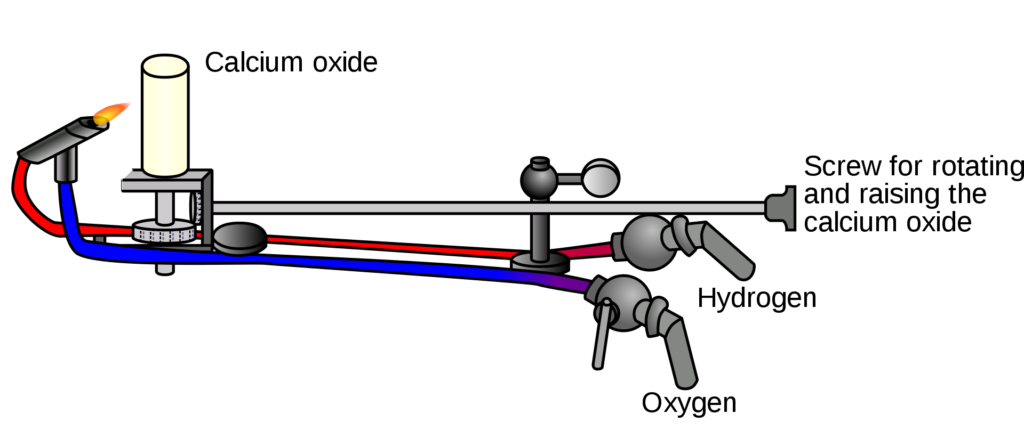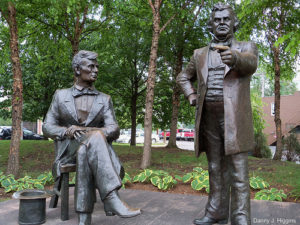 In 1858, Abraham Lincoln began following Douglas from town to town as they campaigned against each other for Douglas’s Senate seat. Challenging the incumbent Senator in a Democratic-dominated state, Lincoln had to coax Douglas to go against his own interests and formally debate. Whenever Douglas gave a major speech, Lincoln told the crowd he would respond that evening or the next day. After doing this for a while, and with the help of his influential friend Jesse Fell, Lincoln approached Douglas about holding a series of joint debates across the state. Reluctant at first, Douglas eventually agreed to one debate in each of the nine congressional districts in Illinois. They had both already spoken in Springfield and Chicago within a day of each other, so they agreed to seven additional joint debates in Ottawa, Freeport, Jonesboro, Charleston, Galesburg, Quincy, and Alton over the next two months. For each debate one candidate would speak for sixty minutes, followed by the other for ninety minutes, and the first would get a thirty-minute reply. They alternated who would speak first, with the incumbent Douglas getting the benefit of doing so in four of the seven debates.
In 1858, Abraham Lincoln began following Douglas from town to town as they campaigned against each other for Douglas’s Senate seat. Challenging the incumbent Senator in a Democratic-dominated state, Lincoln had to coax Douglas to go against his own interests and formally debate. Whenever Douglas gave a major speech, Lincoln told the crowd he would respond that evening or the next day. After doing this for a while, and with the help of his influential friend Jesse Fell, Lincoln approached Douglas about holding a series of joint debates across the state. Reluctant at first, Douglas eventually agreed to one debate in each of the nine congressional districts in Illinois. They had both already spoken in Springfield and Chicago within a day of each other, so they agreed to seven additional joint debates in Ottawa, Freeport, Jonesboro, Charleston, Galesburg, Quincy, and Alton over the next two months. For each debate one candidate would speak for sixty minutes, followed by the other for ninety minutes, and the first would get a thirty-minute reply. They alternated who would speak first, with the incumbent Douglas getting the benefit of doing so in four of the seven debates.
The optics of the debates were almost comical. Lincoln was as tall and thin as Douglas was short and wide. Douglas tended toward inflammatory and racist language, while Lincoln was calmer and more logical in his arguments. Douglas had a reputation as a blatant liar; Lincoln as “Honest Abe.” Douglas often arrived in town on a special train accompanied by boisterous bands. Lincoln rode coach. Douglas was prone to histrionics, personal attacks, dogmatic exclamations, blatant negrophobic pandering to white superiority, and lying without remorse. Lincoln avoided sliding in the muck, focusing on making his key points clear to the often large crowds.
Because of the way Illinois was settled—the south moving up from slave states, the central from free states to the east, and the north from the upper states via the Great Lakes—each debate city offered a different range of public opinion. And while topics like banking were briefly mentioned, the main focus of all debates was the defining issue of the day—slavery.
Douglas and Lincoln explored several aspects of the slavery question, with Douglas largely sticking to his stump speech at each stop while Lincoln built on his arguments over time. One aspect was whether slavery was right or wrong. Lincoln argued that slavery was inherently wrong, both from a moral view and from a public policy perspective. Douglas asserted that he “cares not whether slavery is voted down or voted up.” To Douglas, each state could choose whether it wanted slavery, and the federal government had no right to dictate policy. Lincoln disagreed, noting again that the Founders had banned slavery from the territories that became Ohio, Indiana, Illinois, and parts north. The Founders also banned the import of new slaves from Africa. As such, Lincoln argued, the federal government had every right to restrict slavery in the territories, and had done so repeatedly.
Sensing this was a difficult position, Douglas went on the attack. He accused Lincoln and all “Black Republicans” of being abolitionists, intent on removing slavery from all the southern states where it currently existed. Lincoln denied this, reminding people that he acknowledged the Constitution protected slavery where it existed. His goal was simply to stop it from expanding. Douglas took his attacks a step further, accusing Lincoln of being for the full equality of the races. This was a straw man used to play to the flagrant racism that permeated the North as well as the South. Douglas knew that if he could paint Lincoln as a “left wing radical,” it would help his campaign.
But Lincoln was hardly a radical. Today he might be considered a “prudent progressive.” True, he achieved great things, including the radical idea of emancipation, but he did so by sticking to authority constrained by the U.S. Constitution. Lincoln, and most Americans at the time, believed that while slavery was immoral (he once said, “If slavery is not wrong, nothing is wrong”), the acknowledgement of its existence in the Constitution meant the federal government did not have the authority to ban it in the states where it already existed. Each state must take action to remove slavery from within its borders, which is how each of the northern states had achieved their free status. As noted above, however, Lincoln believed that Congress did have the power to block slavery from entering the federal territories and the District of Columbia. He and Congress later took steps to ensure freedom from slavery in both of those.
Later, as President, Lincoln issued the Emancipation Proclamation, which did free enslaved people in those states in active rebellion against the Union. This actually remained consistent with the Constitution as it provided for special powers in case of insurrection, powers that would not have been available in the normal state of affairs. Lincoln used these powers as a military necessity. Acknowledging that the Proclamation would become legally moot once the war ended, Lincoln worked hard to have Congress pass the 13th Amendment to the Constitution, which permanently enshrined the freedom of all men and women regardless of race.
All of this was possible because of the Lincoln-Douglas debates of 1858. In particular, during the second debate in Freeport, Lincoln posed a set of questions to Douglas. Always thinking ahead, Lincoln set a trap, and Douglas had no choice but to fall into what would become known as the Freeport Doctrine. Lincoln asked:
Can the people of a United States Territory, in any lawful way, against the wish of any citizen of the United States, exclude slavery from its limits prior to the formation of a State Constitution?
The question directly pit Douglas’s Popular Sovereignty against the Supreme Court’s Dred Scott decision. Douglas was forced to choose between alienating those people he required to get reelected to the Illinois Senate or the Southerners he needed in his third run for the presidency two years later. He responded that people in a territory could keep out slavery despite the Dred Scott decision, which stated that federal and state governments had no authority to exclude slavery because it would deprive slaveholders of their “property” rights without due process.
Lincoln was ecstatic over Douglas’s response, although he did not show his hand. Southerners, who wanted the ability to expand slavery without limit, had grown concerned that states could choose to exclude slavery in accordance with Douglas’s Popular Sovereignty. They saw the Dred Scott decision as confirming their right to bring slaves wherever they wanted, and now Douglas was saying that was not true. This presented a long-term problem for slave-owning states. While they knew that most of the new territories were grossly inadequate for growing cotton, which was still the primary driver of the need for slaves, they recognized that every new slave state would increase their representation in Congress—and their continued power to dictate policy.
When the votes were counted, Lincoln had won the popular vote and the Republican Party picked up seats in the legislature. But the state legislature, which was majority Democratic, was still choosing Senators. Douglas retained his Senate seat. Lincoln likely realized his chances of winning the seat were close to nil because of the legislature’s makeup. When he was asked why he would give Douglas an advantage for Senate reelection, Lincoln replied that he had a longer view in mind: Douglas might win the Senate, but he would lose the presidency. The Freeport Doctrine would see to that.
The rest, as they say, is history.
[Adapted from Lincoln: The Man Who Saved America]
David J. Kent is an avid traveler, scientist, and Abraham Lincoln historian. He is the author of Lincoln: The Man Who Saved America, Tesla: The Wizard of Electricity and Edison: The Inventor of the Modern World as well as two specialty e-books: Nikola Tesla: Renewable Energy Ahead of Its Time and Abraham Lincoln and Nikola Tesla: Connected by Fate.
Check out my Goodreads author page. While you’re at it, “Like” my Facebook author page for more updates!



 Abraham Lincoln is the only president to appoint a tenth justice to the Supreme Court. He made five appointments, one of the most prolific appointers-in-chief in our history. And it all started because of Dred Scott.
Abraham Lincoln is the only president to appoint a tenth justice to the Supreme Court. He made five appointments, one of the most prolific appointers-in-chief in our history. And it all started because of Dred Scott.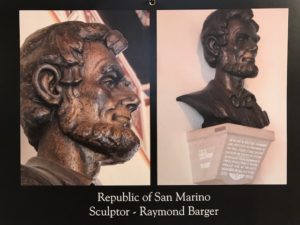 September in the 2020 calendar series by David Wiegers brings us to the tiny city state of San Marino, where Abraham Lincoln not only makes a showing, he’s a citizen.
September in the 2020 calendar series by David Wiegers brings us to the tiny city state of San Marino, where Abraham Lincoln not only makes a showing, he’s a citizen.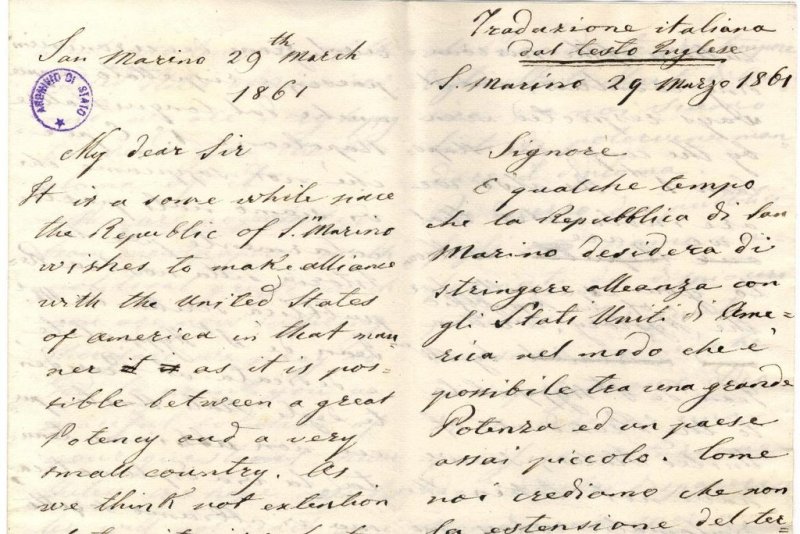
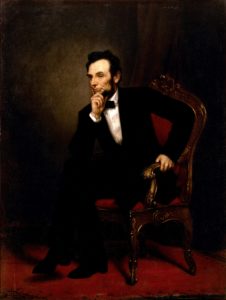 Abraham Lincoln and the Devil? That’s a connection most people wouldn’t easily make, but did you know that Abraham Lincoln had a particular affinity for the fable of Faust?
Abraham Lincoln and the Devil? That’s a connection most people wouldn’t easily make, but did you know that Abraham Lincoln had a particular affinity for the fable of Faust?